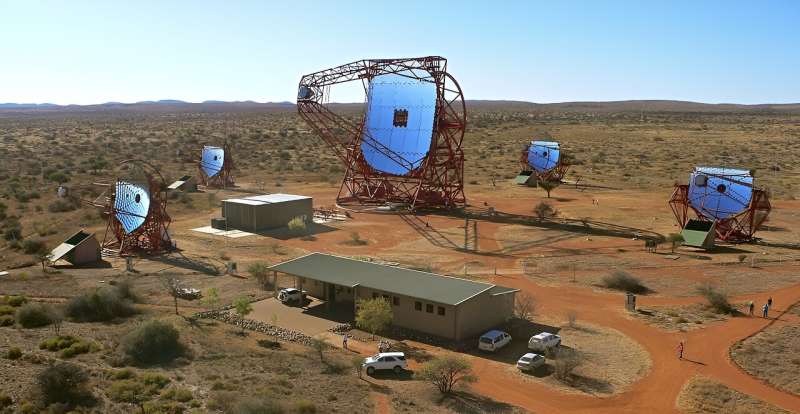May 28, 2024 feature
This article has been reviewed according to Science X's editorial process and policies. Editors have highlighted the following attributes while ensuring the content's credibility:
fact-checked
preprint
trusted source
proofread
Detecting 'Hawking radiation' from black holes using today's telescopes

In 1974 Stephen Hawking famously claimed that black holes should emit particles as well as absorb them. This so-called "Hawking radiation" has not yet been observed, but now a research group from Europe has found that Hawking radiation should be observable by existing telescopes that are capable of detecting very high energy particles of light.
When two massive black holes collide and merge, or a neutron star and black hole do so, they emit gravitational waves, undulations in the fabric of spacetime that travel outward. Some of these waves wash over Earth millions or billions of years later. These waves were predicted by Einstein in 1916 and first directly observed by the LIGO detectors in 2016. Dozens of gravitational waves from black hole mergers have been detected since.
These mergers also emit a number of "black hole morsels," smaller black holes with masses of the order of an asteroid, created in the resulting extremely strong gravitational field around the merger due to so-called "nonlinear," high velocity effects in general relativity. These nonlinearities arise due to the inherently complex solutions to Einstein's equations, as warped spacetime and masses feedback on one another and both respond to and create new spacetime and masses.
This complexity also generates gamma ray bursts of extremely energetic photons. These bursts have similar characteristics, with a time delay from the merger of the order of their evaporation time. A morsel mass of 20 kilotons has an evaporation lifetime of 16 years, but this number can change drastically since the evaporation time is proportional to the morsel mass cubed.
Heavier morsels will initially provide a steady gamma ray burst signal, characterized by reduced particle energies, proportional to the Hawking temperature. The Hawking temperature is inversely proportional to a black hole's mass.
The research team showed, through numerical calculations using an open source public code called BlackHawk that calculates the Hawking evaporation spectra for any distribution of black holes, that the Hawking radiation from the black hole morsels creates gamma ray bursts that have a distinctive fingerprint. The work is published on the arXiv preprint server.
Detecting such events, which have multiple signals—gravitational waves, electromagnetic radiation, neutrino emissions—is called multimessenger astronomy in the astrophysical community, and is part of the observing programs at the LIGO gravitational wave detectors in the US, VIRGO in Italy and, in Japan, the KAGRA gravitational wave telescope.
Visible signals from black hole evaporation always include photons above the TeV range (a trillion electron volts, about 0.2 microjoules; for example, the CERN Large Hadron Collider in Europe, the largest particle accelerator on the planet, collides protons head-on with a total energy of 13.6 TeV). This provides a "golden opportunity," the group writes, for so-called high energy atmospheric Cherenkov telescopes to detect this Hawking radiation.
These Cherenkov telescopes are ground-based antenna dishes that can detect very energetic photons (gamma rays) in the energy range of 50 GeV (billion electron volts) to 50 TeV. These antennae accomplish that by detecting Cherenkov radiation flashes that are produced as the gamma rays cascade through the Earth's atmosphere, traveling faster than the ordinary wave velocity of light in air.
Recall that light travels slightly slower in air than it does in a vacuum, because air has an index of refraction slightly greater than one. The Hawking gamma ray radiation cascading down through the atmosphere exceeds this slower value, creating Cerenkov radiation (also called braking radiation—Bremsstrahlung in German). The blue light seen in pools of water that surround reaction rods in a nuclear reactor is an example of Cerenkov radiation.
There are now four telescopes that can detect these cascades of Cerenkov radiation—the High Energy Stereoscopic System (HESS) in Namibia, the Major Atmospheric Gamma Imaging Cherenkov Telescopes (MAGIC) on one of the Canary Islands, the First G-APD Cherenkov Telescope (FACT), also on La Palma Island in the Canary archipelago, and Very Energetic Radiation Imaging Telescope Array System (VERITAS) in Arizona. Though each uses different technology, they all can detect Cerenkov photons in the GeV-TeV energy range.
Detecting such Hawking radiation would also shed light (ahem…) on the production of black hole morsels, as well as particle production at energies higher than can be attained on Earth, and may carry signs of new physics such as supersymmetry, extra dimensions, or the existence of composite particles based on the strong force.
"It was a surprise to find that black hole morsels can radiate above the detection capabilities of current high energy Cherenkov telescopes on Earth," said Giacomo Cacciapaglia, lead author from the Université Lyon Claude Bernard 1 in Lyon, France. Noting that direct detection of Hawking radiation from black hole morsels would be the first evidence of the quantum behavior of black holes, he said "if the proposed signal is observed, we will have to question the current knowledge of the nature of black holes" and morsel production.
Cacciapaglia said they plan to contact colleagues from experimental groups, then to use the data collected to search for the Hawking radiation they propose.
More information: Giacomo Cacciapaglia et al, Measuring Hawking Radiation from Black Hole Morsels in Astrophysical Black Hole Mergers, arXiv (2024). DOI: 10.48550/arxiv.2405.12880
Journal information: arXiv
© 2024 Science X Network





















